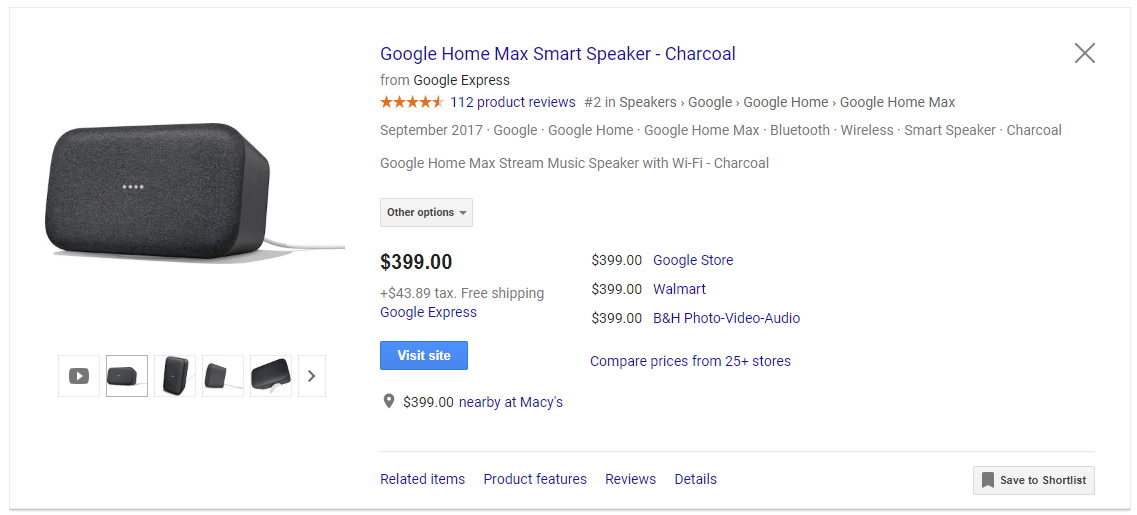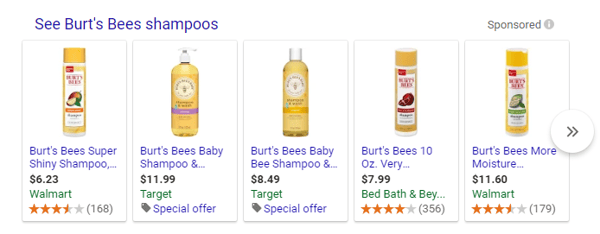
Since their launch in 2010, Google Shopping Ads have steadily become an important part of successful eCommerce marketing. These ads have consistently proven themselves to be more effective than traditional PPC Google text ads, and businesses of all sizes are taking note. In the first quarter of 2018, 76.4% of retail search ad spending was directed to Google Shopping Ads.
Over the last several years, Google Shopping Ads have evolved into a profitable marketing channel for many businesses. Google's updates dramatically altered the paid marketing landscape, and over time transformed Google Shopping from an optional sales tactic into a must-have ad format for eCommerce businesses worldwide.
Google Shopping Ads appear in two main places: on Google Shopping (formerly Google Product Search), and at the top of search results when a user searches for a product with a regular Google search. The ads can also appear in image searches.
The bottom line is that Google Shopping Ads mean lots of exposure and big growth. For many merchants, they're the key to driving brand awareness and outperforming competitors. If you’re on the fence about whether Google Shopping Ads are right for your business, check out the following five benefits that may persuade you.

1. Put your products and brand in the Google Shopping spotlight.
Whether you’re a small business just starting out or an established name, appearing at the top of search engine result pages (SERPS) helps drive consumers to purchase your products. Customers don't need to be familiar with your business or brand to find you through Google, as your products can appear whenever Google matches them to the user's search keywords.
Since Google Shopping Ads ensure your products will appear above organic search results, you’ll be able to easily and effectively expand your brand’s online visibility. One of the reasons these ads are so good at matching prospective customers to your business is that your products are shown based on the shopper's keywords. This means your products are displayed to users who are already interested in what you sell.
2. Your Google Shopping Ads will perform better than your text-based ads.
There’s a reason more and more retailers are allocating more of their marketing budget toward Google Shopping Ads over text ads. Since a consumer who purchases your image-featured Google Shopping Ad is showing a high purchase intent, it’s no surprise the ads have a higher conversion rate. Studies show that Google Shopping Ads generate 26% higher conversion rates and have a 23% lower cost-per-click than text ads.
A better ROI is always an advantage in business, especially when it comes to marketing and advertising. These often have very uncertain results. Google Shopping Ads provide a higher return on investment because your every advertising dollar is focused on the right customers. If a shopper isn't looking for your product, your ad won't be shown; simple as that.
Between the high conversion rate and better targeting, Google Shopping Ads are far more effective than AdWords text ads. The other formatting, such as product images and star ratings, also make them more attractive to click on. In Q1 of 2018, 60% of search ad clicks were on Google Shopping Ads, showing a clear preference over text-based ads.
3. Get better qualified leads from Google Ads.
By providing relevant product information, Google Shopping Ads help you increase the quality of your leads. Shoppers are looking to make an informed purchasing decision, and through visually revealing, information rich ads, visitors land on your product page with a high intent to purchase. It’s also because of this fact that Google Shopping Ads often garner double or triple the click-through rate of text ads.
With Google Shopping Ads, the customer can see enough information within the ad that they're already a little familiar with your product when they arrive at your website. The ads consist of your product image and name, price, your brand name, and product star rating. Shoppers who don't recognize your brand name are still likely to click your ad based on the image, rating, and price.
Clicking the ad will bring the customer directly to your product. Since they already knew what to expect, they're less likely to bounce. Since the user will spend at least a few moments on the page (adding the product to their cart, etc.), you have a chance to entice the shopper to explore your online store and become a repeat customer. Do this with compelling design, offer boxes, or other attention-grabbing methods.
4. Google Shopping is a lot easier to manage.
Text ads require advertisers to select and bid on the keywords they want to target. Google Shopping Ads are much simpler and eliminate the keyword process entirely. Instead of bidding on keywords, Google decides what keywords are relevant based on your product data feed (which you can strategically craft for better results).
You set up your Google Shopping Feed in your Google Merchant Center account. You can pull product data directly into Google through the use of an app that connects your online store through Google Shopping's API. For example, 3dcart's Automatic Google Shopping Feed app will collect product data, and then send it to your Google Merchant Center account to set up your products. The data will be correctly structured to include product images, ratings, and other information. The feed will then automatically update to ensure all your Google Shopping Ads remain accurate when they display on Google SERPs.
With Google Shopping, you're just sending your product data to Google, which does all the work of matching keywords to your products. Compare this to AdWords in which you need to research the keywords yourself, and you'll see the difference in time and effort.
5. Benefit from broader reach with Google Shopping Ads.
With Google Shopping campaigns, your ads have the potential to appear more than once for a single query. For example, if someone searched for “Burt’s Bees Shampoo,” three of your products may appear: “Burt’s Bees Baobab Shampoo, 10 Fl Oz,” “Burt’s Bees Baby Shampoo and Wash, 12 Fl Oz,” and “Burt’s Bees Very Volumizing Shampoo, 10 Fl Oz.”

Since Google is also choosing the keywords for which to show your products, you might find that your products start to show up for related keywords you may not have guessed. An exact match isn't required and Google is getting smarter about using synonyms properly, so the search itself is pretty flexible. For example, a search for "sneakers" pulls up a couple of products with the word "sneakers" in the name, but also "cross trainer" and "shoes."
With AdWords text ads, you would have needed to bid on all these keywords separately, but not with Google Shopping. You can reach more customers regardless of what words they personally use to describe the products they want.
Conclusion
The savviest minds and the biggest businesses are allocating more their marketing budgets toward Google Shopping Ads. If you’re looking to stay on trend with your competitors, it may be time to revamp your marketing efforts in favor of today’s paid marketing trend.
Not up to running your own Google Shopping Ads? Use a shopping cart software that is easy to use with Google Shopping ads.





Leave a reply or comment below